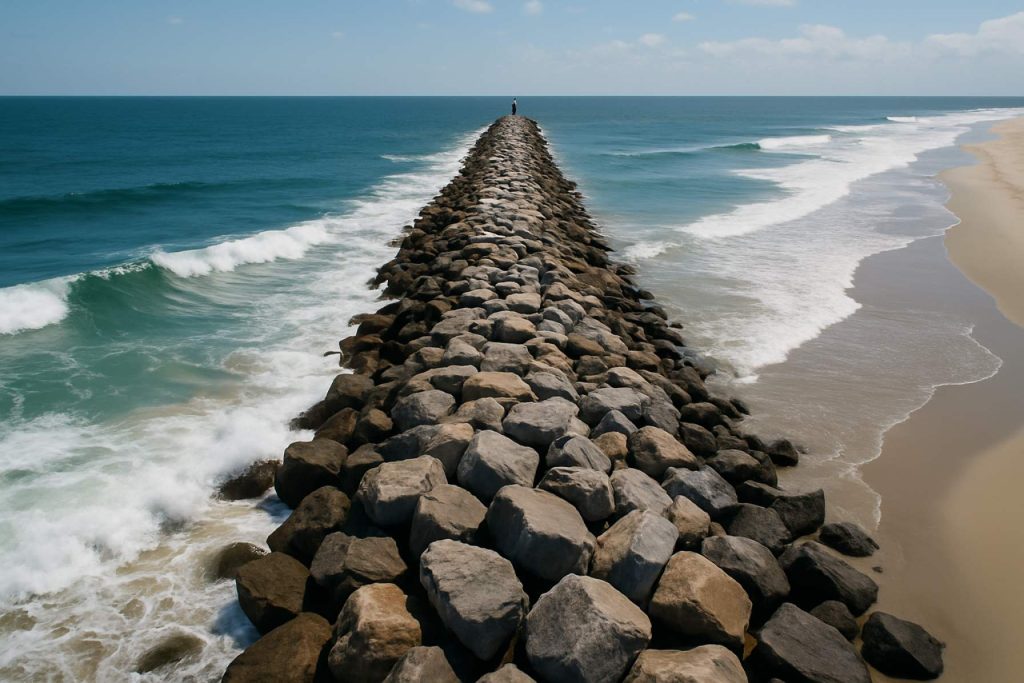
Mastering Jetty Dynamics in Coastal Engineering: How Structure, Sediment, and Innovation Redefine Shoreline Protection and Harbor Performance (2025)
- Introduction to Jetty Dynamics: Definitions and Historical Context
- Physical Principles: Hydrodynamics and Sediment Transport Around Jetties
- Design Considerations: Materials, Geometry, and Environmental Impact
- Case Studies: Iconic Jetty Projects and Lessons Learned
- Modeling and Simulation: Tools for Predicting Jetty Performance
- Jetty-Induced Coastal Morphology Changes
- Technological Innovations: Smart Materials and Monitoring Systems
- Environmental and Regulatory Challenges in Jetty Construction
- Market Trends and Future Outlook: Growth, Public Interest, and Sustainability (Estimated 15% Increase in Global Coastal Infrastructure Investment by 2030, per pianc.org)
- Conclusion: The Evolving Role of Jetty Dynamics in Coastal Resilience
- Sources & References
Introduction to Jetty Dynamics: Definitions and Historical Context
Jetty dynamics in coastal engineering refer to the study and management of the physical processes and interactions that occur around jetties—elongated structures built from the shore into a body of water, primarily to influence currents, protect harbors, and control sediment transport. The term encompasses the hydrodynamic, sedimentary, and ecological changes induced by the presence and design of jetties. As of 2025, the field is increasingly focused on understanding these dynamics to optimize jetty performance, minimize environmental impacts, and adapt to changing coastal conditions.
Historically, jetties have been constructed for centuries, with early examples dating back to Roman and medieval harbors. Their primary function has been to stabilize navigation channels and protect coastal infrastructure from wave action and sedimentation. Over time, the understanding of jetty-induced changes in coastal morphology has evolved, particularly with the advent of modern coastal engineering in the 20th century. The development of numerical modeling, remote sensing, and in-situ monitoring technologies has significantly advanced the ability to predict and manage jetty dynamics.
In recent decades, the focus has shifted from purely structural considerations to a more integrated approach that accounts for the complex interplay between jetties, waves, currents, and sediment transport. This shift is driven by the recognition that poorly designed or maintained jetties can lead to unintended consequences such as accelerated erosion, habitat loss, and navigation hazards. Organizations such as the U.S. Army Corps of Engineers—a leading authority in coastal infrastructure—have played a pivotal role in developing guidelines and best practices for jetty design and management, emphasizing adaptive strategies and environmental stewardship.
As of 2025, the historical context of jetty dynamics is increasingly relevant due to the growing impacts of climate change, sea level rise, and intensified coastal development. These factors necessitate a deeper understanding of how jetties interact with evolving coastal systems. International bodies like the World Association for Waterborne Transport Infrastructure (PIANC) and the UNESCO Intergovernmental Oceanographic Commission are actively promoting research and knowledge exchange on sustainable coastal engineering practices, including jetty dynamics.
Looking ahead, the next few years are expected to see continued advancements in monitoring technologies, data analytics, and modeling capabilities, enabling more precise assessments of jetty impacts and more resilient coastal infrastructure solutions. The integration of historical insights with cutting-edge science will remain central to addressing the challenges and opportunities presented by jetty dynamics in coastal engineering.
Physical Principles: Hydrodynamics and Sediment Transport Around Jetties
Jetty dynamics in coastal engineering are fundamentally governed by the interplay of hydrodynamic forces and sediment transport processes. As of 2025, research and field observations continue to emphasize the critical role of jetties in modifying local wave climates, current patterns, and sediment pathways. Jetties, typically constructed perpendicular to shorelines at tidal inlets or river mouths, act as barriers that disrupt the natural littoral drift, leading to both accretion and erosion phenomena on adjacent coastlines.
Hydrodynamically, jetties alter wave refraction and diffraction patterns, often resulting in increased wave energy concentration at their tips and in the lee of the structures. This can intensify local scour and create complex eddy systems, as documented in recent field studies using advanced acoustic Doppler current profilers and remote sensing techniques. The U.S. Army Corps of Engineers, a leading authority in coastal infrastructure, has reported that these hydrodynamic modifications can extend several hundred meters from the jetty, influencing navigation channels and adjacent habitats.
Sediment transport around jetties is primarily driven by the interruption of longshore sediment flux. On the updrift side, sediment tends to accumulate, forming salient or tombolo features, while the downdrift side often experiences sediment starvation and chronic erosion. The magnitude of these effects depends on jetty length, orientation, and local wave climate. Recent monitoring programs, such as those coordinated by the National Oceanic and Atmospheric Administration (NOAA), have provided high-resolution data on shoreline change rates and sediment budgets, enabling more accurate predictions of jetty-induced morphological evolution.
In 2025, there is a growing emphasis on integrating real-time hydrodynamic and sediment transport data into numerical models to forecast the impacts of existing and proposed jetty structures. These models, validated against field measurements, are increasingly used by agencies like the U.S. Army Corps of Engineers to optimize jetty design and maintenance, aiming to balance navigation safety with shoreline stability and ecosystem health.
Looking ahead, the outlook for jetty dynamics research involves the deployment of more autonomous monitoring platforms and the application of machine learning to interpret large datasets. This is expected to enhance the predictive capability of coastal engineers, supporting adaptive management strategies in the face of sea level rise and changing storm patterns. International collaboration, led by organizations such as the World Association for Waterborne Transport Infrastructure (PIANC), is also anticipated to drive the development of best practices and innovative solutions for sustainable jetty management.
Design Considerations: Materials, Geometry, and Environmental Impact
In 2025, the design of jetties in coastal engineering is increasingly shaped by a combination of advanced materials science, refined geometric modeling, and heightened environmental awareness. The selection of construction materials remains a critical factor, with reinforced concrete, steel, and high-density polyethylene (HDPE) being the most prevalent. Recent years have seen a shift toward corrosion-resistant alloys and composite materials, aiming to extend jetty lifespan and reduce maintenance costs, particularly in aggressive marine environments. For example, the use of fiber-reinforced polymers (FRPs) is gaining traction due to their high strength-to-weight ratio and resistance to saltwater-induced degradation, as documented by the American Society of Civil Engineers.
Geometry plays a pivotal role in jetty performance, influencing wave reflection, sediment transport, and navigational safety. Modern design approaches employ computational fluid dynamics (CFD) and physical modeling to optimize jetty alignment, length, and cross-sectional profile. These methods allow engineers to predict and mitigate adverse effects such as scour at the jetty toe or unwanted sediment deposition in navigation channels. The U.S. Army Corps of Engineers, a leading authority in coastal infrastructure, continues to refine guidelines for jetty geometry, emphasizing adaptability to site-specific hydrodynamic and sedimentary conditions.
Environmental impact assessments are now integral to jetty design, reflecting both regulatory requirements and a broader commitment to coastal ecosystem health. Key considerations include the potential for habitat disruption, changes in littoral drift, and water quality impacts. In 2025, there is a notable trend toward incorporating nature-based solutions, such as integrating artificial reefs or living shorelines adjacent to hard structures, to enhance biodiversity and shoreline resilience. The National Oceanic and Atmospheric Administration (NOAA) actively supports research and pilot projects that blend traditional engineering with ecological restoration.
Looking ahead, the next few years are expected to bring further integration of real-time monitoring technologies—such as embedded sensors for structural health and environmental parameters—into jetty projects. These advances will enable adaptive management, allowing for timely interventions in response to changing coastal dynamics or extreme weather events. As climate change accelerates sea level rise and intensifies storm patterns, the emphasis on resilient, sustainable jetty design will only increase, with ongoing collaboration among engineering bodies, environmental agencies, and academic institutions shaping best practices worldwide.
Case Studies: Iconic Jetty Projects and Lessons Learned
In recent years, the study of jetty dynamics in coastal engineering has been shaped by several high-profile projects and ongoing research, offering valuable lessons for future infrastructure. As of 2025, the focus has shifted toward resilience, adaptability, and environmental integration, driven by climate change, rising sea levels, and increased coastal development.
One of the most instructive case studies is the rehabilitation of the Port of Los Angeles’ Main Channel jetties. This project, completed in phases through 2023, addressed severe scour and settlement issues caused by increased vessel traffic and more frequent storm surges. Engineers implemented a combination of traditional rock armoring and innovative geotextile containment systems to stabilize the jetty core, while real-time monitoring systems were installed to track structural responses to dynamic loading. The project demonstrated the importance of adaptive management and the integration of sensor technology for ongoing maintenance (Port of Los Angeles).
In Europe, the Port of Rotterdam’s Maasvlakte 2 expansion, finalized in the early 2020s, provided a large-scale example of jetty design under extreme hydrodynamic conditions. The project’s jetties were constructed using a combination of Xbloc concrete armor units and natural stone, designed to withstand North Sea wave climates and projected sea level rise. Post-construction monitoring has shown that the modular approach allows for targeted repairs and upgrades, a key lesson for future-proofing coastal infrastructure (Port of Rotterdam Authority).
Australia’s Fremantle Harbour North Mole jetty, which underwent significant repairs in 2022-2024, highlighted the challenges of aging infrastructure. The project team used advanced numerical modeling to predict sediment transport and wave overtopping, informing the placement of new armor layers and toe protection. The case underscored the necessity of integrating modern modeling tools with traditional engineering knowledge to extend the lifespan of legacy structures (Fremantle Ports).
Looking ahead, the next few years are expected to see increased adoption of nature-based solutions, such as hybrid jetties that incorporate living shorelines or artificial reefs to enhance ecological value while maintaining structural function. International bodies like PIANC (the World Association for Waterborne Transport Infrastructure) are actively developing guidelines for such approaches, reflecting a broader industry shift toward sustainability and resilience in jetty design and management.
Modeling and Simulation: Tools for Predicting Jetty Performance
In 2025, modeling and simulation remain at the forefront of predicting jetty performance, with advances in computational power and data integration driving more accurate and actionable insights for coastal engineers. The dynamic interaction between jetties and their surrounding environments—waves, currents, sediment transport, and extreme weather events—necessitates sophisticated tools to anticipate both short-term and long-term impacts.
State-of-the-art numerical models, such as those based on the finite element and finite volume methods, are now routinely employed to simulate hydrodynamic and morphodynamic processes around jetties. These models, including widely used platforms like Delft3D and MIKE 21, allow engineers to assess scenarios ranging from daily tidal cycles to rare storm surges. The Deltares institute, a global leader in water and subsurface modeling, continues to refine these tools, integrating real-time data assimilation and machine learning algorithms to enhance predictive accuracy.
Recent years have seen a surge in the use of high-resolution bathymetric and topographic data, collected via LiDAR, multibeam sonar, and satellite remote sensing. This data feeds directly into simulation models, enabling more precise representation of jetty geometry and adjacent seabed features. The United States Geological Survey (USGS) and the National Oceanic and Atmospheric Administration (NOAA) are among the organizations providing open-access datasets that underpin many of these modeling efforts.
Physical modeling, though less dominant than in previous decades, still plays a critical role in validating numerical simulations. Facilities such as the U.S. Army Engineer Research and Development Center (ERDC) continue to operate large-scale wave basins and flumes, where scaled jetty models are subjected to controlled hydrodynamic conditions. These experiments inform calibration and verification of digital models, ensuring that simulation outputs remain grounded in physical reality.
Looking ahead, the integration of artificial intelligence and cloud-based computing is expected to further transform jetty performance modeling. Real-time monitoring networks, coupled with adaptive simulation frameworks, will enable near-instantaneous assessment of jetty response to evolving coastal conditions. This is particularly relevant as climate change accelerates sea level rise and intensifies storm patterns, demanding more resilient and adaptive coastal infrastructure. International collaborations, such as those coordinated by the World Association for Waterborne Transport Infrastructure (PIANC), are fostering the development of standardized modeling protocols and data sharing practices, setting the stage for more robust and globally applicable jetty design methodologies in the coming years.
Jetty-Induced Coastal Morphology Changes
Jetty-induced coastal morphology changes remain a central concern in coastal engineering, especially as climate variability and increased maritime activity place new demands on shoreline infrastructure. Jetties, which are typically constructed to stabilize navigation channels and protect harbor entrances, significantly alter sediment transport dynamics and nearshore hydrodynamics. In 2025, ongoing research and monitoring efforts are providing new insights into the short- and long-term morphological impacts of jetty structures.
Recent field studies and numerical modeling have confirmed that jetties disrupt the natural littoral drift, often leading to pronounced accretion on the updrift side and erosion on the downdrift side. This sediment imbalance can result in the formation of tombolos, spit elongation, and channel shoaling, which may necessitate frequent dredging and adaptive management strategies. For example, the U.S. Army Corps of Engineers—a leading authority in coastal infrastructure—has documented ongoing sedimentation issues at major U.S. ports, prompting the development of sediment bypassing systems and real-time monitoring networks.
In 2025, the integration of remote sensing technologies and high-resolution bathymetric surveys is enhancing the ability to track morphological changes in near real-time. Organizations such as the National Oceanic and Atmospheric Administration are leveraging satellite imagery and LiDAR to map shoreline evolution and inform adaptive management. These data-driven approaches are critical for anticipating the impacts of extreme weather events, which are projected to increase in frequency and intensity due to climate change.
Internationally, coastal authorities are also prioritizing the ecological consequences of jetty-induced changes. The World Association for Waterborne Transport Infrastructure (PIANC) is actively developing guidelines for environmentally sustainable jetty design, emphasizing the need to balance navigational safety with habitat preservation. In Europe and Asia, pilot projects are underway to test nature-based solutions, such as integrating artificial reefs or dynamic revetments adjacent to jetties, to mitigate downdrift erosion and support biodiversity.
Looking ahead, the outlook for jetty-induced coastal morphology changes is shaped by advances in predictive modeling, stakeholder engagement, and regulatory frameworks. As coastal populations and infrastructure investments grow, adaptive management—grounded in robust scientific data and international best practices—will be essential to minimize adverse impacts and ensure the resilience of both human and natural coastal systems.
Technological Innovations: Smart Materials and Monitoring Systems
In 2025, the field of coastal engineering is witnessing significant advancements in the application of smart materials and monitoring systems to enhance the performance and resilience of jetties. These innovations are driven by the need to address increasingly complex challenges posed by climate change, rising sea levels, and more frequent extreme weather events. The integration of smart technologies is transforming both the construction and maintenance of jetty structures, with a focus on real-time data acquisition, adaptive response, and sustainability.
Smart materials, such as self-healing concrete and corrosion-resistant composites, are being deployed in new jetty projects and retrofits. Self-healing concrete, for example, incorporates microcapsules or bacteria that activate upon cracking, autonomously repairing minor damage and extending the service life of the structure. This technology is being evaluated in pilot projects by leading research institutions and coastal authorities, aiming to reduce maintenance costs and improve structural integrity over time. Similarly, advanced fiber-reinforced polymers (FRPs) are being used to strengthen jetty piles and decks, offering high durability in harsh marine environments.
On the monitoring front, the adoption of Internet of Things (IoT) sensors and remote monitoring platforms is accelerating. These systems provide continuous, real-time data on structural health, wave loading, scour, and sediment transport around jetties. For instance, wireless sensor networks can detect early signs of fatigue, displacement, or scour, enabling proactive maintenance and reducing the risk of catastrophic failure. The U.S. Army Corps of Engineers, a key authority in coastal infrastructure, is actively researching and implementing such technologies in its jetty management programs, with several demonstration projects underway.
Additionally, the use of unmanned aerial vehicles (UAVs) and autonomous underwater vehicles (AUVs) for inspection and data collection is becoming standard practice. These platforms can rapidly survey large areas, providing high-resolution imagery and bathymetric data to inform dynamic modeling and adaptive management strategies. The World Association for Waterborne Transport Infrastructure (PIANC), an international organization dedicated to waterborne transport infrastructure, is publishing guidelines and case studies on the integration of these technologies in jetty design and maintenance.
Looking ahead, the next few years are expected to see further convergence of smart materials and digital monitoring, with artificial intelligence and machine learning playing a growing role in predictive maintenance and risk assessment. These innovations are poised to set new standards for jetty resilience, safety, and environmental stewardship in coastal engineering worldwide.
Environmental and Regulatory Challenges in Jetty Construction
Jetty construction in coastal engineering faces increasingly complex environmental and regulatory challenges as of 2025, driven by heightened awareness of ecosystem impacts, evolving climate conditions, and stricter governance. The dynamic interaction between jetties and coastal processes—such as sediment transport, tidal flows, and habitat connectivity—has prompted regulatory bodies to demand more comprehensive environmental impact assessments (EIAs) and adaptive management strategies.
Recent years have seen a surge in regulatory requirements for jetty projects, particularly in regions with sensitive marine habitats or where coastal erosion is a concern. For example, the United States Environmental Protection Agency (EPA) and the U.S. Army Corps of Engineers have updated permitting frameworks to require detailed modeling of hydrodynamic changes and sediment budgets associated with new or modified jetties. These agencies now emphasize the need for nature-based solutions and mitigation measures, such as artificial reefs or living shorelines, to offset potential negative impacts on coastal ecosystems.
Globally, organizations like the United Nations Environment Programme (UNEP) and the International Maritime Organization (IMO) are promoting best practices for sustainable coastal infrastructure. Their guidelines encourage the integration of climate resilience into jetty design, accounting for sea level rise projections and increased storm intensity. In 2025, several coastal nations are aligning their national regulations with these international standards, requiring project proponents to demonstrate long-term adaptability and minimal ecological disruption.
Data from recent projects indicate that regulatory delays and additional compliance costs are becoming more common. For instance, in Australia, the Department of Climate Change, Energy, the Environment and Water has mandated cumulative impact assessments for all major jetty developments, leading to extended review periods but also improved environmental outcomes. Similarly, the European Union’s Directorate-General for Environment enforces the Habitats Directive, which restricts construction in or near protected areas unless strict mitigation is demonstrated.
Looking ahead, the outlook for jetty construction involves greater collaboration between engineers, ecologists, and regulators. The adoption of digital monitoring tools and real-time data analytics is expected to enhance compliance and adaptive management. As regulatory frameworks continue to evolve, successful jetty projects will increasingly depend on early stakeholder engagement, transparent reporting, and the integration of innovative, ecosystem-based design principles.
Market Trends and Future Outlook: Growth, Public Interest, and Sustainability (Estimated 15% Increase in Global Coastal Infrastructure Investment by 2030, per pianc.org)
The global focus on coastal resilience and infrastructure modernization is driving significant growth in the field of jetty dynamics within coastal engineering. As of 2025, public and governmental interest in sustainable shoreline protection and port efficiency is at an all-time high, with projections indicating an estimated 15% increase in global coastal infrastructure investment by 2030, according to the PIANC (the World Association for Waterborne Transport Infrastructure), a leading international organization dedicated to the development of sustainable waterborne transport infrastructure.
Recent years have seen a surge in large-scale jetty construction and rehabilitation projects, particularly in regions vulnerable to sea level rise and extreme weather events. For example, several national port authorities and coastal management agencies are prioritizing the integration of advanced materials and adaptive design principles to enhance jetty resilience and reduce maintenance costs. The adoption of real-time monitoring systems, utilizing sensors and remote data acquisition, is becoming standard practice for tracking structural health and sediment dynamics around jetties, as reported by the U.S. Army Corps of Engineers, a major authority in coastal engineering research and implementation.
Sustainability is a central theme in current and future jetty projects. There is a marked shift toward nature-based solutions, such as hybrid structures that combine traditional hard engineering with ecological enhancements to support biodiversity and natural sediment transport. This approach aligns with the recommendations of the United Nations Environment Programme (UNEP), which advocates for infrastructure that balances human needs with environmental stewardship.
Looking ahead, the next few years are expected to bring further innovation in jetty design, including the use of low-carbon construction materials and digital twin technologies for predictive maintenance and performance optimization. The increasing frequency of climate-driven coastal hazards is likely to accelerate the deployment of adaptive and modular jetty systems, enabling rapid response to changing shoreline conditions. International collaboration, knowledge sharing, and adherence to evolving best practices—facilitated by organizations like PIANC—will be critical in ensuring that jetty dynamics continue to support both economic development and coastal sustainability.
Conclusion: The Evolving Role of Jetty Dynamics in Coastal Resilience
As coastal regions worldwide confront intensifying challenges from sea level rise, increased storm frequency, and shifting sediment dynamics, the role of jetty dynamics in coastal engineering is undergoing significant evolution. In 2025 and the coming years, the integration of advanced modeling, real-time monitoring, and adaptive management strategies is shaping how jetties are designed, maintained, and optimized for coastal resilience.
Recent events underscore the urgency of this evolution. For example, the U.S. Army Corps of Engineers—a leading authority in coastal infrastructure—has accelerated research and pilot projects focused on the interplay between jetty structures and sediment transport, particularly in high-risk areas along the Atlantic and Gulf coasts. Their ongoing initiatives leverage high-resolution hydrodynamic models and remote sensing to predict and mitigate unintended consequences such as downdrift erosion and navigation channel infilling.
Data from 2024–2025 field campaigns, including those coordinated by the National Oceanic and Atmospheric Administration (NOAA), reveal that adaptive jetty management—such as adjustable crest heights and modular extensions—can significantly reduce maintenance costs and environmental impacts. These findings are influencing new design guidelines and operational protocols, with a focus on balancing navigation safety, habitat preservation, and shoreline stability.
Internationally, organizations like PIANC (the World Association for Waterborne Transport Infrastructure) are facilitating knowledge exchange on jetty performance under climate stressors. Their technical working groups are developing best practices for integrating nature-based solutions, such as living shorelines and sediment bypass systems, with traditional jetty infrastructure. This hybrid approach is gaining traction in regions like Northern Europe and East Asia, where coastal populations and assets are particularly vulnerable.
Looking ahead, the outlook for jetty dynamics in coastal engineering is characterized by increasing interdisciplinarity and digitalization. The adoption of real-time data analytics, machine learning, and digital twins is expected to enhance predictive capabilities and support proactive decision-making. As regulatory frameworks evolve to incorporate climate adaptation and ecosystem services, jetty projects will likely become more holistic, emphasizing resilience over rigid structural control.
In summary, the evolving role of jetty dynamics is central to the future of coastal resilience. Through collaborative research, technological innovation, and adaptive management, coastal engineers and stakeholders are redefining the function of jetties—not just as static barriers, but as dynamic, responsive elements within complex coastal systems.



